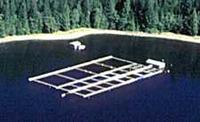Aquaculture, Fin Fish
AQUACULTURE, FIN FISH, refers to the cultivation of fin fish in a controlled environment, such as tanks, ponds or net cages. Commonly called fish farming, it is carried on in BC by both the public and private sectors and is limited almost exclusively to salmonids and TROUT. Other fin fish species being cultured in limited or experimental quantities in BC include SABLEFISH (blackcod), HALIBUT, STURGEON, Arctic CHAR and carp. The government's primary role is to culture salmonids in their early life stages, releasing fry into river systems or lakes to enhance wild populations. Many non-profit clubs and associations also are involved in the operation of salmonid enhancement facilities. The private sector operates hatcheries at the first stage of fish farming, where fish are held in captivity throughout their lives. When ready to enter salt water, salmon fry are transferred to net pens rather than being released. Fish are fed fish meal and reared to market size, then harvested as they reach adulthood. BC fish farmers raise coho and chinook (see SALMON, PACIFIC) and Atlantic Salmon (see SALMON, ATLANTIC), as well as a small quantity of rainbow trout.
Commercial salmon farming began on the West Coast in the mid-1970s, when several applicants were granted licences to raise fish in salt water net pens on the SUNSHINE COAST and in ALBERNI INLET. In the early 1980s dozens of facilities opened on the South Coast, particularly in JERVIS and SECHELT inlets. In the late 1980s a series of HARMFUL ALGAL BLOOMS (which use the available oxygen in the water and clog the fish's gills), heavy storms and low market prices precipitated an industry-wide reorganization as small farms closed, amalgamated with others or were purchased by large multinational companies. The centre of the industry shifted north and west, into colder water where algal blooms were less frequent. By the mid-1990s salmon farms were concentrated from QUADRA ISLAND north along the INSIDE PASSAGE to the islands around JOHNSTONE STRAIT and on the west coast of VANCOUVER ISLAND near TOFINO. There are about 125 licensed farm sites, with anywhere from 70-85 active at any one time. More than 80% are owned by 3 companies: HERITAGE SALMON LTD (now Mainstream Canada), MARINE HARVEST CANADA and Grieg Seafood. BC farms produced 76,300 tonnes of farmed salmon in 2009, making the province the fourth largest producer in the world after Norway, Chile and the United Kingdom. Of these, over 90% were Atlantic salmons; the rest were chinook and a small amount of coho and marine trout. Of the total production, 85% was exported, mainly to the US. Chief market competitors are the wild salmon fishery, as well as farmed product from Chile and Norway.
There is controversy concerning the salmon farming industry and its ENVIRONMENTAL impact, particularly in relation to the siting of farms, the transmission of diseases, the use of antibiotics and the mixing of farmed fish and wild salmon stocks. Most recently, alarms have been raised about the impact of sea lice infestations in wild pink salmon populations in the vicinity of farms, particularly in the area of the Broughton archipelago. Despite these concerns, in 2002, after a prolonged review, the provincial government lifted a 7-year moratorium on new farms and gave approval to expansion of the industry. Then, in 2008, in response to further concerns, the government re-imposed a moratorium for the area north of Klemtu. Critics of ocean-sited net pens argue that many of the problems associated with salmon farming would be addressed if the industry transitioned to a land-based closed containment system. As of 2013 there was one closed containment facility in operation on an experimental basis in BC, near Port McNeill on Vancouver I.
Trout farming is another aspect of fin fish aquaculture in BC. The majority of BC trout farms consist of tanks or ponds on private property. Most trout growers in the North and Interior of the province have a limited growing season. They purchase fry in the spring and sell fish weighing 500 g–1 kg in the fall. On Vancouver Island and in the FRASER VALLEY, growers are able to maintain their ponds all year round. Fry are supplied to BC growers from a handful of operators who maintain brood fish and hatcheries.
by Carol Swann
Reading: Betty C. Keller and Rosella M. Leslie, Sea-Silver: Inside BC's Salmon-Farming Industry, 1996; Stephen Hume, et.al., A Stain Upon the Sea: West Coast Salmon Farming, 2004; Peter A. Robson, Salmon Farming: The Whole Story, 2006.

